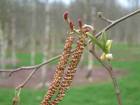Red Alder Tree Information
Images of Red Alder:






Red Alder grows in the following 7 states and provinces:
Alaska, British Columbia, California, Hawaii, Idaho, Oregon, WashingtonInformation about Red Alder:
The Alnus Rubra is commonly known as the Oregon Alder, Pacific Coast Alder, Red Alder as well as Western Alder.
The currently accepted scientific name of red alder is Alnus rubra Bong. . There are no recognized subspecies, varieties, or forms.Red alder is confined to the Pacific Coast region from southeast Alaska to southern California. Although there is an isolated population growing along streams in northern Idaho, it ordinarily occurs no further inland than 100 miles (160 km) at elevations below 2,500 feet (762 m) . Red alder is cultivated in Hawaii .Red alder communities, both upland and riparian, generally are found within coniferous forests dominated by Douglas-fir (Pseudotsuga menziesii), western redcedar (Thuja plicata), western hemlock (Tsuga heterophylla), grand fir (Abies grandis), and Sitka spruce (Picea sitchensis) , or as components of deciduous forests of floodplains or swamps . Generally, five types of red alder communities have been described : (1) Upland, pure even aged stands of red alder, with a dense shrub undergrowth dominated by salmonberry (Rubus spectabilis) or elderberry (Sambucus melanocarpa), occurring within coniferous forests. (2) Upland mixed stands of red alder/other deciduous trees and shrubs/conifers within coniferous forests less than 100 years old, with red alder occurring as a dominant or codominant. (3) Riparian red alder communities within coniferous forests. (4) Mixed stands within deciduous riparian forests, red alder occurring as codominant with black cottonwood (Populus trichocarpa) and bigleaf maple (Acer macrophyllum). (5) In swamps often occurring with, or codominant with, western redcedar. In this type of community, red alder appears to be a climax species. Red alder communities were primarily restricted to streams and wet areas during presettlement times. Since then, disturbances such as logging have provided an abundance of open sites with bare mineral soil, which favor red alder colonization. Today red alder communities are common throughout much of coastal Oregon and Washington. Published classification schemes listing red alder as an indicator species or as a dominant part of the vegetation in community types (cts) or plant associations (pas) are presented below: Area Classification Authority AK general veg. cts Viereck & others 1992 CA hardwood forest & Barbour 1987 woodland cts CA general veg. cts Thorne 1976 s CA general veg. cts Paysen & others 1980 nw CA,w Or,w WA general veg. cts Franklin 1979 OR: Siuslaw NF general veg. pas Hemstrom & Logan 1986 OR postburn veg. cts Bailey & Poulton 1968 s OR: Cascade Mtns forest pas Atzet & McCrimmon 1990 OR, WA general veg. cts Franklin & Dyrness 1973 Pacific NW general veg. cts Hall 1984Some of the information provided here is attributed to:Uchytil, Ronald J. 1989. Alnus rubra. In: Fire Effects Information System, [Online]. U.S. Department of Agriculture, Forest Service, Rocky Mountain Research Station, Fire Sciences Laboratory (Producer). , available at the USDA Fire Effects Information System (FEIS) website